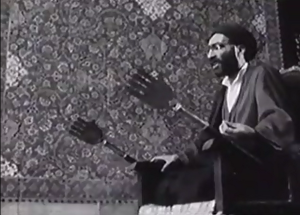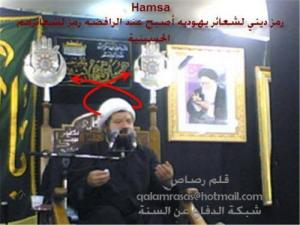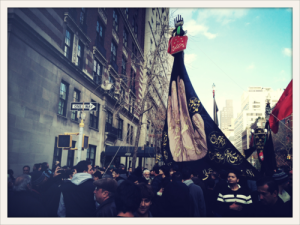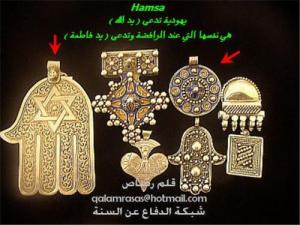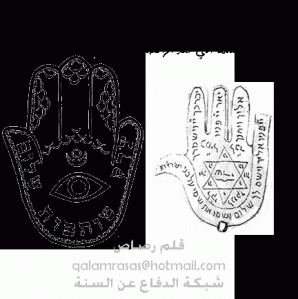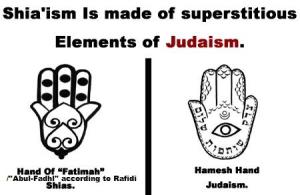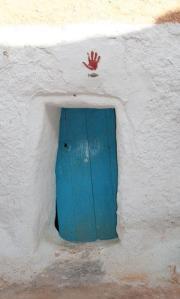MUSLIM NAZI (Muslim Nationalism)
La Illah Illallah Muhammadur Rasulullah. There is no Lord but Allah and Muhammad (PBUH) is His Messenger.
Saturday, 1 November 2014
Thursday, 30 October 2014
The Jewish Khamsa/Hamsa in Rafidite Shi’ite culture
The Jewish Khamsa/Hamsa in Rafidite Shi’ite culture
Popular and of RELIGIOUS importance among all polytheist sects and ignorant Muslims.
- Levantine Mushrik (mostly Lebanese) Christians call it the “hand of Mary”, for the mother of Jesus
- Mushrik Jews name it hamsa, but renamed it the hand of Miriam (Mary)
- In North-Africa, though being a Sunni Muslim area, nevertheless the Maghrebwas once ruled by FATIMID-RAFIDITE HERETIC, who introduced all sorts of superstition into society, including the JEWISH “Khamsa/Hamsa” (though being known in the Maghreb as the “Hand of Fatima”. That is why one can find it among the Ignorant masses of north Africa. Hence it is a RAFIDITE leftover i.e. has no basis in the creed of the Ahl Al-Sunnah of the Maghreb people).
- The Rafidi (twelver Shia) sect has it’s own interpretation of this PAGAN, WATHANI (polytheistic) symbol. They take it as a symbol for the chopped hands of Abal-Fadhl Al-Abbas (rahimahullah) the half-brother of Al-Hussein whose hands had been cut off at the battle of Karbala. This pagan-Jewish symbol can be found in SHI’ITE religious centres, festivals etc. all over the world:
“Ayatollah” Al-Khoie centre in New York/Brooklyn proudly declaring their Saba’ite origin:
In some Jewish communities the “Hamsa/Khamsa” is still be painted over the door, for the sake of protection:
And since Shi’ism is of Jewish origin, there is no wonder that this Jewish symbol is an ESSENTIAL RELIGIOUS symbol of Shi’ism, to such an extent that the following unbelievable news, is sadly true:
“The chopped off hands of Abal-Fadhl Al-Abbas” (i.e. the Jewish Hamsa pagan symbol) are suppose to protect the new Iraqi (American Shia backed regime) of t Aeroplanes [Arabic news source] !
All the Mushriks and Esoterics have gathered here to share their love for the HAND with the ONE EYE in the middle:
As for the personality of Ibn Saba’ the Yemenite Jewwhose existence (!) had been completely denied by some recent contemporary Shia scholars (in opposition to the major Shia scholars of the past like Nowbakhti who AFFIRMED his existence, and Al-Kulayni who narrated authentic narrations, confirming his existence), here is a video with clear-cut proof references proving that Ibn Saba’ DID exist and was indeed the first who spread the idea of the “divine leadership” of the Household of the Prophet and the cursing of the Prophet’s (صل الله عليه و سلم) companions:
Monday, 27 October 2014
Islam and the Ottoman Empire
If you read many Western histories of the Ottoman Empire, you may not even learn that the Ottomans were a Muslim empire. They are often seen as a typical European multi-cultural empire whose only purpose in existence was to promote its own interests. The truth is far from this, however. Throughout its history from the 1300s to the early 1900s, the Ottoman Empire was a strongly Muslim state at its core. Islamic law and ideas formed the basis of society, law, and government. Ottoman sultans saw themselves as the protectors of the Muslim world. With this emphasis on Islam, however, protection for other religions in the empire was ensured in ways that would take Christian Europe centuries to match.
The Ghazis
At the very beginning, the Ottoman state was nothing more than a small tribal alliance led by a Turkish bey, by the name of Osman. His beylik (small state) in western Anatolia bordered the hostile Byzantine Empire. Osman was known as a ghazi, or a soldier of the faith. In the Turkish culture of the time, huge emphasis was placed on being a Muslim soldier defending Muslim lands against Byzantine attacks. The Byzantines had been in a state of war with Muslim empires on and off since the Righteous Caliphate of Abu Bakr, Umar, Uthman, and Ali.

The first Ottoman sultan, Osman, set a precedent of Islam being an integral part of the Ottoman state.
Under Osman, the Turks of Anatolia found a common identity in sticking to Islam in all walks of life, and using their expertise as soldiers in defense of Muslim lands. This emphasis on Muslim identity is seen in Osman’s advice to his son:
Son! Be careful about the religious issues before all other duties. The religious precepts build a strong state. Do not give religious duties to careless, faithless and sinful men or to dissipated, indifferent or inexperienced people. And also do not leave the state administrations to such people. Because the one without fear of God the Creator, has no fear of the created…Depend on God’s help in the esteem of justice and fairness, to remove the cruelty, attempts in every duty. Protect your public from enemy’s invasion and from cruelty.
Clearly, the patron of the Ottoman Empire (Ottoman is a Latin corruption of Osmanli, the Turkish name for their empire) placed great emphasis on Islam as a pillar of his state. All subsequent sultans of the Ottoman Empire were coronated with Osman’s sword by a religious scholar. This symbolized the status of the sultans as the defenders of Islam.
Leaders of the Muslim World
From their humble beginnings as a small Turkish state in the 1300s, the Ottomans would grow to become the premier Muslim empire throughout the 15th to 19th centuries. In 1517, the Ottoman Empire extended its domain to include the Arabic-speaking regions of North Africa, Egypt, Syria, Iraq, and the Arabian Peninsula. With this, they now controlled the 3 holy sites – Makkah, Madinah, and Jerusalem – and thus bore the responsibility of the protectors of the holy cities.

Makkah in 1910, during the Ottoman reign in the city. The square arcade around the Ka’bah still stands today as the inner-most part of the mosque.
In the holy cities, the Ottomans placed much emphasis on the protection and preservation of Islam’s most important places. The oldest parts of the current Masjid al-Haraam in Makkah, the inner arcade of pillars, was built by the Ottomans in the 1500s. In Madinah, the Ottoman Sultan Suleyman greatly decorated the grave of Prophet Muhammad (Peace Be Upon Him), while also protecting the grave from damage with a brass and gold covering that still stands today. In Jerusalem, Sultan Suleyman ordered the rebuilding of the city’s walls, which also still stand.
Besides just architectural achievements, the Ottomans were the ensurers of the yearly pilgrimage to Makkah. They organized official processions of pilgrims from Yemen, Central Africa, and Iraq. The main pilgrimage routes however were through Damascus and Cairo. Every year the sultan would appoint a special delegate who would lead the pilgrimage from Damascus. He would take with him vast amounts of gold and silver as a gift to the people of Makkah and Madinah to help support them economically. During the reign of Sultan Abdulhamid II in the late 1800s, a railway was built from Istanbul to Madinah, to help transport the hundreds of thousands of pilgrims going to the holy cities.

Much of the older part of Masjid al-Nabawi in Madinah, including the house of Muhammad (PBUH) [above] was built or renovated by the Ottomans
Islam and Government
Unlike the modern secular ideas regarding government separation from religion, the Ottomans felt that Islam should play a vital role in the government. After 1517, the Ottoman sultan was also the caliph or khalifah of the Muslim world. The caliph ideally plays a role as a spiritual and political leader of all Muslims worldwide. With the sultan-caliph at the top of the government, a complex religious bureaucracy developed that ran the religious affairs of the empire.
According to Islamic law, the most important and basic duty of a Muslim ruler, particularly a caliph, was to maintain Islamic law throughout the empire – the shari’ah. Scholars of Islamic law, the ‘ulema, were organized in a heirarchical fashion. At the top were two top Islamic judges that were permanent members of the sultan’s group of advisors. Under them were the qadis, or judges, of the major cities of the empire, such as Damascus, Cairo and Baghdad. They oversaw all the laws of the Ottoman Empire, and presided over civil and criminal cases in their cities. For example, a qadi‘s job included diving up inheritance after someone’s death, finding solutions between two feuding parties, and prosecuting criminals. These qadis also oversaw lesser qadis that presided in smaller towns throughout the empire.

Sultan Suleyman Kanunipersonally sorted through the Ottoman Empire’s laws with the mufti of Istanbul to make sure they all abided by Islamic guidelines
Before laws could be sent down to individual qadis throughout the empire, they had to pass through another Islamic branch of the government. Separate and independent from the sultan was the mufti of Istanbul – also known as theshaykh al-Islam. Mufti is an Arabic word meaning a scholar qualified to interpret religious laws, and shaykh al-Islam means “the scholar of Islam”. The shaykh al-Islam had the right to review any laws the sultan wanted to implement, and reject the ones that went against the shari’ah. In many cases, the sultans would work closely with him to ensure all of the empire’s laws conformed with Islam. For example, Sultan Suleyman was nicknamed Kanuni, meaning “the law giver” because he personally went through all the empire’s laws in the mid-1500s with the shaykh al-Islam to ensure none contradicted Islamic laws.
The Millet System
While analyzing the Ottoman Empire’s Islamic character, one must keep in mind that much of the empire’s population was not Muslim. Large communities of Orthodox Christians, Jews, and Catholics all lived in the empire. At some times, Muslims even formed a minority of the empire’s population. At no time in the empire’s history were non-Muslims forced to abide by any Muslim laws. Instead, a system of religious pluralism, known as the millet system, was implemented. In the millet system, each religious group was organized into a millet, or nation.
Each millet was allowed to run by its own rules, elect its own leaders, and enforce their own laws on their people. For example, after the conquest of Constantinople in 1453, Sultan Mehmed II had the Orthodox Christian community of the city elect a new patriarch, who served as their leader. By not enforcing Islamic laws on non-Muslims, the Ottoman Empire ensured social and religious stability and harmony within its borders for much of its history. Contrary to this, throughout the rest of Christian Europe, religious freedom only began to take root in the 1700s and 1800s. Denial of rights and persecution of non-Christians continued, however, as is seen in the Holocaust of the 1940s and the ethnic cleansing of Muslim Bosnians in the 1990s.
Conclusions
While the successor state of the Ottoman Empire, Turkey, officially employs a policy of state secularism, the history of the Ottoman Empire is intertwined with Islamic history. For centuries, the Ottomans were the protectors of the Islamic faith. They presided over the holy sites of Islam, and made it their mission to protect Muslims from outsiders. Islamic law was the fundamental basis of the empire’s law system itself. Along with this emphasis on Islam, non-Muslims never had their rights violated, and in fact found stability and protection in the Ottoman Empire.
Bibliography:
Hourani, Albert Habib. A History Of The Arab Peoples. New York: Mjf Books, 1997. Print.
Itzkowitz, Norman. Ottoman Empire And Islamic Tradition. Chicago: University Of Chicago Press, 1981. Print.
Thursday, 23 October 2014
Deadly Alliances Against Muslims in Asia
Muslim extremists is bad but radical Buddhist is fine to this stupid world fuck media
http://www.nytimes.com/2014/10/16/opinion/deadly-alliances-against-muslims.html?_r=0
http://www.nytimes.com/2014/10/16/opinion/deadly-alliances-against-muslims.html?_r=0
Saturday, 18 October 2014
Subscribe to:
Posts (Atom)
